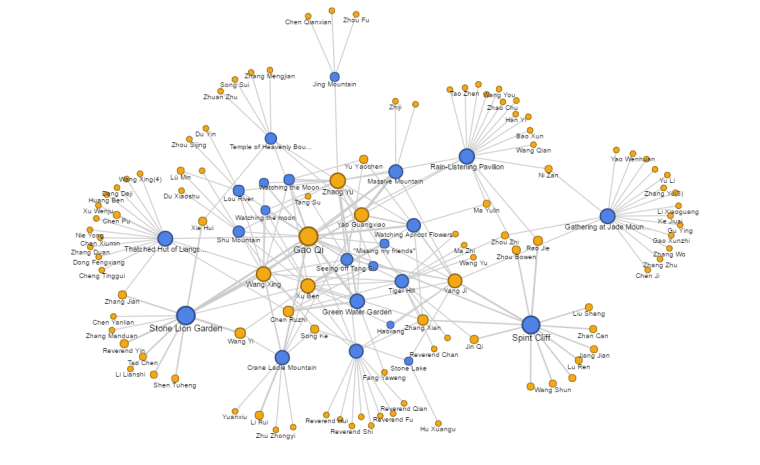I am currently writing an MA Thesis on the "Ten Friends of the North City Wall" (Beiguo Shi You 北郭十友). The image that we have of this group is mainly based on later sources and a few contemporary sources that describe a group of more or less ten young poets who were active during the late Yuan and early Ming in a district near the north walls of Suzhou. We know little of the inner dynamics of this network and how they as a group fit within a larger local network of Suzhou elites during the fourteenth century.
For my research I chose an approach based on the activities that these ten individuals performed together. Examining what activities people joined in, when and where, can provide context for understanding a social relationship. Together the “Ten Friends” composed around 5000 poems spread over 10 different collections. This huge amount of material raises for me the methodological problem how to identify the poems that help me find these activities. It is at this point that I found MARKUS especially useful. I used it to find the relevant joint activities that I would need for my research and it helped me to decide how to approach these activities.
First, I manually marked all the personal names and locations that appear in the titles of all the poems. I was then able to filter out exactly those poems in which multiple person names appeared together. These poems were often composed at an event that involved multiple individuals or they describe such an event having taken place. These poems also often told me who participated in an event, where, and when the activity was held. My results also allowed me to see at a glance which individuals participated in which activities, and which activities attracted the highest number of people. It also showed me at which places important social activities took place. I complemented my search with a key-word markup of all the other personal names and place names that appear in the poems that I had found. This helped me to find all the remaining poems that can be associated with a certain activity. This way using MARKUS I was able to find roughly twenty joint activities between the “Ten Friends” and others.
Then, I used my findings to create a network graph that links individuals (orange) to social activities (blue). The graph visualizes which gatherings, which individuals, and which places were most significant to this social network. Center activities were important in maintaining relationships between the “Ten Friends of the North City Wall” themselves, while periphery activities were less impactful on their internal network, but provided them with important opportunities to extend their circle outwards.

Social network graph of the “Ten Friends of the North City Wall” based on shared participation in activities (https://goo.gl/zP5HE4)
By locating the places on the map, and separating them into private (red) and public places (blue), I was able to quickly visualize the geographical spread of the activities. From the map I concluded that activities at privately owned places like rural residencies or exile destinations brought them far outside the North City Wall district in Suzhou where they lived together. Even while they were sent to various places, their involvement in activities at more public places like scenic sites, monasteries, and local estates, suggest a strong sense of local involvement.

Geographical spread of the social network of the “Ten Friends of the North City Wall” (crop) (https://goo.gl/uVKlr8)
I used MARKUS in the early stages of my research. These early results already suggest that the North City Wall district only played a small part in the social network of the “Ten Friends of the North City Wall”. In all the 5000 poems I couldn’t find a single poem or prose piece that describes a concrete joint activity or experience that took place between ten or so individuals in this part of the city. MARKUS has shown me that to understand what bound this group together through the Yuan-Ming transition one has to look elsewhere. As the graph shows, one has to take into account a complex network of activities involving for each activity a different set of individuals. I have found relationships with a wide variety of individuals: with friends, politicians, famous artists, patrons, landowners, monks, etc. Each of these relationships have their separate activities, places, and memories. As can be seen from the map, the geographical center of this group is not fixed to a single place but shifts around, while it suggests a strong sense of locality.
Overall, the visualizations were a helpful tool throughout the whole research process and allowed me to determine what approach suited each activity best and how to relate each activity to other activities. MARKUS can be a useful tool that can bring us closer to understanding and visualizing the complexities of how social networks developed in time and space during the transitional period of the late Yuan and early Ming.
Levi Voorsmit, MA student, Leiden University